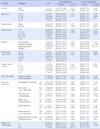Abstract
Purpose
The aim of this study was to examine the relationship between job characteristics, organizational culture, job satisfaction and turnover intention, including the direct and indirect effects of the variables on turnover intention.
Methods
A questionnaire was completed by a convenience sample of 144 nurses working for two public institutions. Data were analyzed using independent t-test, One-way ANOVA, Pearson correlation, Hierarchical multiple regression and Path analysis with SPSS/WIN 21.0 and AMOS 21.0 programs.
Results
The mean score for job satisfaction and turnover intention was similar to that of other hospital nurses. The factors affecting job satisfaction were: position, number of job changes, relationship-oriented culture, and hierarchical-oriented culture(Adj. R2=.48, F=14.43, p<.001). The factors affecting turnover intention were: age, position, overtime, and job satisfaction(Adj. R2=.61, F=19.48, p<.001). Job autonomy and relationship-oriented culture had a significant indirect effect on turnover intention.
Figures and Tables
Table 1
Differences of Job Satisfaction, Turnover Intention by Characteristics of Participants (N=144)

References
1. Hospital Nurses Association. Hospital nurses staffing state survey [Internet]. Seoul: Hospital Nurses Association;2013. cited 2014 September 22. Available from: http://khna.or.kr/web/information/resource.php.
2. Korean Statistical Information Service. Survey on wages and working hours at establishments [Internet]. Deajeon: Statistics Korea;2013. cited 2014 October 31. Available from: http://kosis.kr/statHtml/statHtml.do?orgId=118&tblId=DT_118N_MONA31&conn_path=I3.
3. Kim JK, Kim MJ. A review of research on hospital nurses' turnover intention. J Korean Acad Nurs Adm. 2011; 17(4):538–550. DOI: 10.11111/jkana.2011.17.4.538.
4. Hackman J, Richard , Oldham GR. Development of the job diagnostic survey. J Appl Psychol. 1975; 60(2):159–170.
5. Lee JW. The mediating role of job involvement in the relationships between job characteristics and employee attitudes. Korean J Manage. 1997; 5(1):87–122.
6. Er KS, Hur HK, Kim KK, Cho YJ, Kim EH, Kim SJ. The relationship between job characteristics, job satisfaction, and intents to leave among hospital nurses. Clin Nurs Res. 2004; 9(2):81–92.
7. Kim KK, Hur HK. A comparative study on the job characteristics and job satisfaction in correctional nurses and hospital nurses. J Korean Acad Nurs Adm. 2003; 9(2):233–241.
8. Portoghese I, Galletta M, Battistelli A, Leiter MP. A multilevel investigation on nursing turnover intention: the cross-level role of leader-member exchange. J Nurs Manag. 2014; 01. 12. DOI: 10.1111/jonm.12205.
9. Lim CH. Organizational behavior. 5th ed. Seoul: B&M Books;2013.
10. Kathryn M, Chou SS, Stone PW. Organizational climate and health care outcomes. Jt Comm J Qual Patient Saf. 2007; 33:11 Suppl. 45–56.
11. Cameron KS, Quinn RE. Diagnosing and changing organizational culture: Based on the competing values framework. 3rd ed. San Francisco, CA: Jossey-Bass;2011.
12. Choi WC. Factors related to burnout and job satisfaction among civil servants: focused on the organizational culture of public health division. [master's thesis]. Gyungsan: Daegu Hanny University;2011.
13. Choi SH, Jang IS, Park SM, Lee HY. Effects of organizational culture, self-leadership and empowerment on job satisfaction and turnover intention in general hospital nurses. J Korean Acad Nurs Adm. 2014; 20(2):206–214. DOI: 10.11111/jkana.2014.20.2.206.
14. Han SJ. A study on the relationship between nursing organizational culture and organizational performance. J Korean Acad Nurs Adm. 2002; 8(3):441–456.
15. Park JS. The causal relationship between public hospital nurses's perception of organizational culture types and job satisfaction and turnover intention. Health Soc Sci. 2006; 19:97–118.
16. Lee EJ, Han JY, Kim MY. Effects of the organizational culture on the job satisfaction and organization commitment. J Korean Acad Nurs Adm. 2008; 14(1):5–12.
17. Kang CH, Huh SY, Lee JM, Chung SW, Cho SM. Cross-sector job mobility and job satisfaction change among college graduates. Korea Soc Policy Rev. 2012; 19(2):9–38. DOI: 10.17000/kspr.19.2.201206.9.
18. Spector PE. Measurement of human service staff satisfaction: Development of the job satisfaction survey. Am J Community Psychol. 1985; 13:693–713.
19. Choi YS. The influence on job satisfaction and organizational commitment of the members in social welfare organization by professional identity and chief executive's leadership: The analysis of multi-level [dissertation]. Seoul: Seoul Women's University;2011. 170–172.
20. Lawler EE. Satisfaction and behavior. In : Hackman JR, Lawler EE, editors. Perspectives on behavior in organizations. New York: McGraw-Hill;1983. p. 78–97.
21. Kim YR. A study on the turnover intention of the oncology nurse [master's thesis]. Gwangju: Chonnam National University;2007.
22. Kim MR, Seomun GA. Relationships among burnout, job satisfaction, organizational commitment and turnover intention to resign in hospital nurses. Korean J Occup Health Nurs. 2013; 22(2):93–101. DOI: 10.5807/kjohn.2013.22.2.93.
23. Kim SY, Lee GY, Sook BS. Influence of job characteristics and organizational communication on the job satisfaction of hospital nurses. Health Soc Sci. 2013; 33:135–159.
24. Lee SY. The influence of job characteristics and professionalism on empowerment perceived by nurses. J Korean Acad Nurs Adm. 2006; 12(4):587–596.
25. Park KK. Human resource management. 5th ed. Seoul: Hongmoonsa;2013.
26. Shin YG. Human-oriented management. Seoul: Dasan;2005.
27. Lee HJ, Park HJ. Organizational behavior. Paju: Bubmoonsa;2004.
28. Yom YH, Kwon SB, Lee YY, Kwon EK, Ko JW. The determinants of job satisfaction of nurses: focused on work rewards. J Korean Acad Nurs. 2009; 39(33):329–337. DOI: 10.4040/jkan.2009.39.3.329.
29. Nooney JG, Unruh L, Yore MM. Should I stay or should I go? Career change and labor force separation among registered nurses in the U.S. Soc Sci Med. 2010; 70(12):1874–1881. DOI: 10.1016/j.socscimed.2010.02.037.
30. Barron D, West E. Leaving nursing: An event-history analysis of nurses' careers. J Health Serv Res Policy. 2005; 10(3):150–157. DOI: 10.1258/1355819054338924.




 PDF
PDF ePub
ePub Citation
Citation Print
Print






 XML Download
XML Download